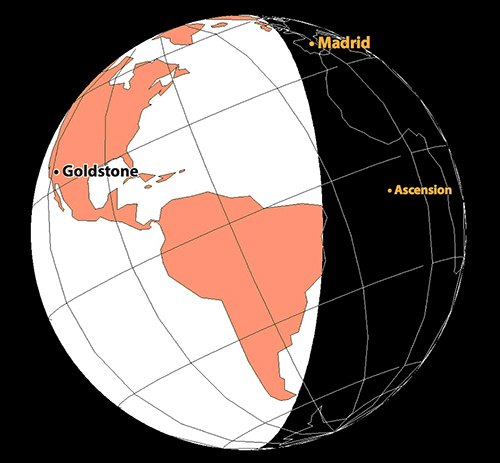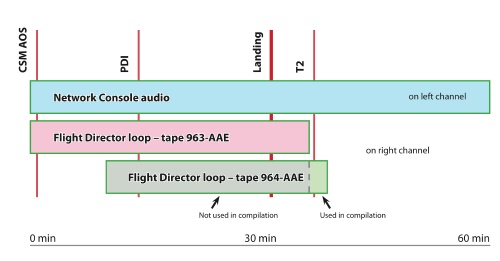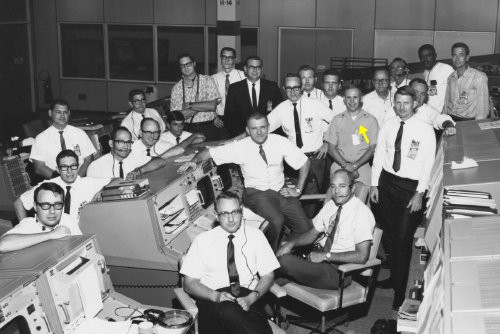On this page:
The
Apollo 11 Descent and Landing – combined sound file.
The Network Controller’s console audio of the Descent and Landing.
The Flight Director’s console audio of the Descent and Landing.
The Network Controller’s console log of the Descent and Landing. |
What was it like to land men on the Moon for the first time?
As Neil Armstrong and Buzz Aldrin descended to the lunar surface, there was plenty of drama, with communications dropouts, an observation they would land long, program alarms, boulder fields, and only just enough fuel.
On Earth, in the MOCR (Mission Operations Control Room, Houston), and on the MSFN (Manned Space Flight Network) the drama was also evident.
Here’s a new compilation – of audio from the Flight Director’s loop, and audio (which was only recently received) from George Ojalehto, the Network Controller on duty for the landing. It’s a tribute to the skill, competence and teamwork of everyone involved.
 The
Apollo 11 Descent and Landing Stereo sound file. The
Apollo 11 Descent and Landing Stereo sound file.
60 min / 29.3MB stereo mp3 file |
This is a stereo sound file synchonising two recordings –
– the Network Controller’s console audio (Capt. George Ojalehto, Network Controller) on the left channel, and
– the Flight Director’s console audio (Gene Kranz, White Team Flight Director) on the right channel.
Both recordings contain the Flight Director’s loop and Air/Ground (Columbia, Eagle and Capcom).
Headphones may be useful.
Network Controller console audio courtesy George Ojalehto via Richard Stachurski. Tape-hiss-reduction, synchronisation and encoding by Colin Mackellar, January 2012. |
See below for how this recording was assembled, and who is heard on it.
|
Capt. George Ojahleto is seated at the Network console in the MOCR, during the Apollo 11 Trans Lunar Coast.
(Bob Carlton, Control, is standing to his left, speaking with Fred Haise.) From 16mm movie footage. |
The first manned lunar landing:
In the minutes leading up to the Powered Descent Insertion, Eagle’s high gain S-band antenna repeatedly lost lock, and the two MSFN stations in view with larger dishes (Madrid with their 85 foot antennae and Goldstone with their 85 foot antennae and 210 foot Mars dish) – struggled to maintain contact. This was a critical time as various Go / NoGo decisions had to be made.
Minutes later, Eagle’s onboard computer issued 1201 and 1202 program alarms threatening an abort, and descent propellant was running low as Neil Armstrong had to fly over a boulder field to a safe landing spot. He landed Eagle with just seconds to spare.
|
The side of the Earth visible from the Moon at the
time Eagle touched down on the lunar surface. (Not all of the MSFN stations are depicted.)
Honeysuckle Creek and Tidbinbilla were not in view – the Moon would not rise there for another 5 hours. |
About the recordings used to make this combined version:
Network Console audio
George Ojalehto, Network Controller on the White Team for the descent and landing, kept a copy of his console’s audio, which was recorded at Comm Control, elsewhere in Building 30 at Houston.
The recording was on two sides of a tape, with a six second gap between the two. The transfer is of variable quality (esp. the second side), with some local variability in tape speed and wow and flutter. Nevertheless, it is probably unique.
This tape begins just before CSM acquisition on the landing revolution (lunar orbit 10), and lasts 60 minutes, ending 28 minutes after touchdown.
Flight Director’s Console audio
The Flight Director’s console audio is courtesy of the Johnson Space Center audio archives and was supplied to the Apollo tape search team via John Sarkissian. Two different, mostly overlapping, recordings of this loop were provided. Both are described in the JSC listing as Apollo 11 FD Loop Cassettes.
JSC tape 963-AAE is the best quality. It begins a few seconds after the NC recording does, just before CSM acquisition. It runs for 37 minutes, ending 5 minutes after touchdown.
JSC tape 964-AAE has a poorer frequency response. It begins 10 minutes after 963-AAE starts, and finishes 2 minutes 20 seconds after 963-AAE ends.
(This means that the Network Console audio has an extra 26 minutes of audio containing the FD loop which may not have been previously available.)
964-AAE was probably recorded at Comm Control, as was the Network Console recording. The better quality copy of 963-AAE has the air/ground audio offset by about half a second with respect to the FD audio.
Being the better quality, 963 was used as the benchmark, and minor edits were made to the Network Controller’s audio [by moving items +/- half a second or so] to keep each segment of conversation in exact sync. Where air/ground and ground conversations were simultaneous, the more relevant item was kept in sync.
963-AAE was likely recorded on a cassette machine in the MOCR, and therefore had a slightly different loop configuration.
Before any of the editing took place, it was necessary to normalise the speed and pitch of the recordings, using the Quindar tones as references. (The JSC recordings originally had been played back too slowly.) Filters were applied to remove hum, and tape hiss was removed as much as possible – without removing noise that was heard on the circuits.
|
Timeline showing the sources used for the combined audio file. |
Voices you’ll hear:
[I need to sit down and write this section… and hopefully identify speakers and times.]
The voices heard include:
Gene Kranz, George Ojelehto, Bob Carlton, Charlie Duke, Don Puddy, and others in the MOCR, Neil Armstrong, Buzz Aldrin, Mike Collins, RTC, TIC, Track, Commtech, Comm Control, Network Ops Support Group, Goldstone, Madrid, Ascension, Antigua, and probably others.
Harry Turner (Ascension) writes: “From Ascension the voices would have been Jim Murphy (M&O) and/or Mel Fetzer. (Asst. M&O).”
Tom Sheehan says that TIC was Auggie Degner.
If you can help with IDs, I would be very grateful of names / positions along with the elapsed time they are heard on the combined recording. Contact.
Highlights
“Job well done” – 420kb mp3 clip – after the landing.
 The
Flight Director’s loop The
Flight Director’s loop
39 min / 9.6MB mp3 file |
This is a restored version of the Flight Director’s console audio using NASA JSC files 964-AAE and 963-AAE, with speed/pitch correction and light noise reduction.
It ends 7 minutes 20 seconds after touchdown. (See the synchronsied file above for FD loop after that point, where some FD loop audio is preserved on the Network Controller console audio.) |
(Thanks to George Ojalehto for his Network recording, which he sent in December 2011.)
|
Descent and Landing
Network Controller Richard Stachurski preserved this page from log at his console in the MOCR (Mission Operations Control Room) in Houston. He writes, “Major John Monkvic supported George Egan and I by keeping the log.”
Click the image for a 3-page PDF file. August 2022 scan.
|
Note: Other than the MSFN stations, there is one other station known to be listening in to Eagle at the landing – the Bochum Radio Observatory in West Germany.




